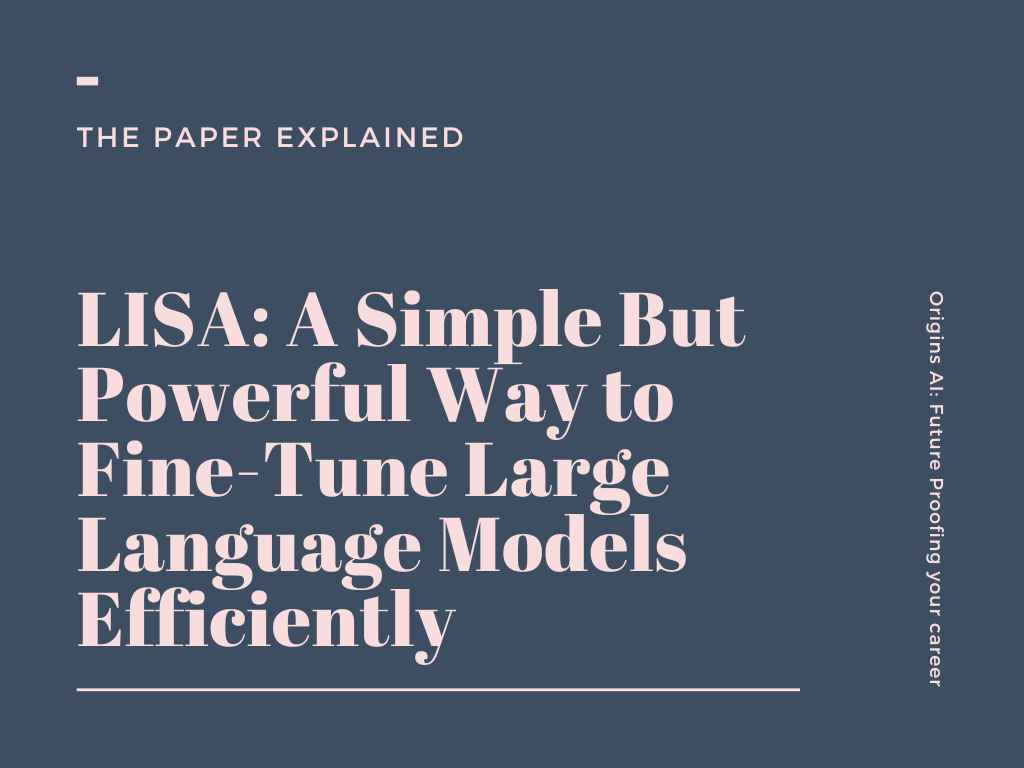Large language models (LLMs) like ChatGPT have revolutionized the field of natural language processing (NLP). However, their massive size presents a significant challenge: memory consumption. Fine-tuning these behemoths requires immense computational resources, hindering their widespread adoption and development.
Researchers have explored various techniques to address this issue. One popular approach is Parameter-Efficient Fine-Tuning (PEFT), which focuses on training only a small subset of the model’s parameters. Among PEFT methods, Low-Rank Adaptation (LoRA) has gained significant traction due to its ability to reduce memory footprint while maintaining decent performance.
However, LoRA still falls short of matching the performance of full parameter training in many large-scale fine-tuning scenarios. This is where LISA (Layerwise Importance Sampling for Memory-Efficient Large Language Model Fine-Tuning) comes into play.
Unveiling LISA: A Closer Look
LISA introduces a surprisingly simple yet effective strategy for fine-tuning LLMs. It builds upon a key observation about LoRA: the weight norms across different layers exhibit an uncommon skewness. The bottom and top layers tend to dominate the updates, while the middle layers contribute minimally.
This observation suggests that different layers have varying importance during the fine-tuning process. LISA leverages this insight by applying the concept of importance sampling. Instead of updating all layers equally, LISA selectively updates only the most crucial ones, leaving the others untouched.
This approach allows LISA to achieve memory efficiency comparable to LoRA, while simultaneously outperforming both LoRA and full parameter training in a wide range of settings.
How Does LISA Work?
LISA operates by randomly freezing layers based on their importance. This importance is estimated by analyzing the weight norms observed in LoRA training. Layers with smaller weight norms in LoRA are assigned lower probabilities of being unfrozen and updated in LISA.
This process effectively mimics LoRA’s update pattern but without the limitations imposed by its low-rank representation ability. Additionally, LISA utilizes the AdamW optimizer, known for its effectiveness in LLM training.
Here’s a simplified view of LISA’s algorithm:
Algorithm 1: Layerwise Importance Sampling AdamW (LISA)
Input:
- Number of layers (NL)
- Number of iterations (T)
- Sampling period (K)
- Sampling probability for each layer ({pℓ})
- Initial learning rate (η0)
Procedure:
- for i = 0 to T/K – 1:
- for ℓ = 1 to NL:
if random number > pℓFreeze layer ℓcontent_copy- Run AdamW optimizer for K iterations
This algorithm iteratively samples layers based on their pre-defined probabilities and updates only the unfrozen ones using AdamW. This selective update strategy allows LISA to achieve remarkable memory efficiency and performance gains.
Putting LISA to the Test: Memory Efficiency and Performance
Extensive experiments were conducted to evaluate LISA’s memory efficiency and performance compared to LoRA and full parameter training. The results are compelling:
- Memory Efficiency: LISA demonstrates comparable or even lower memory consumption than LoRA across various model architectures. This allows for training large models like LLaMA-2-70B on limited resources, even on a single GPU.
- Performance: LISA consistently outperforms LoRA and full parameter training in various tasks, including instruction following, mathematics, and medical question answering. This performance boost is observed across models of different sizes and domains, highlighting LISA’s versatility and effectiveness.
Understanding LISA’s Advantages
Several factors contribute to LISA’s success:
- Efficient Layer Sampling: By focusing on updating only the most important layers, LISA reduces memory consumption and computational overhead without sacrificing performance.
- No Additional Parameters: Unlike LoRA, which introduces extra parameters through adapters, LISA works directly with the original model parameters, leading to a cleaner and more efficient training process.
- Convergence Guarantees: LISA enjoys theoretical convergence guarantees, ensuring its stability and effectiveness in optimizing the loss function.
LISA: A Promising Future for LLM Training
LISA presents a compelling alternative to existing PEFT methods for LLM fine-tuning. Its simplicity, memory efficiency, and superior performance make it a powerful tool for researchers and practitioners working with large language models.
While LISA currently shares the limitation of requiring the entire model to be present in memory during the forward pass, future research directions include exploring techniques like quantization to further reduce memory footprint.
Overall, LISA offers a promising step towards making LLM training more efficient and accessible, paving the way for further advancements in this rapidly evolving field.
To read paper summary like this checkout this page

